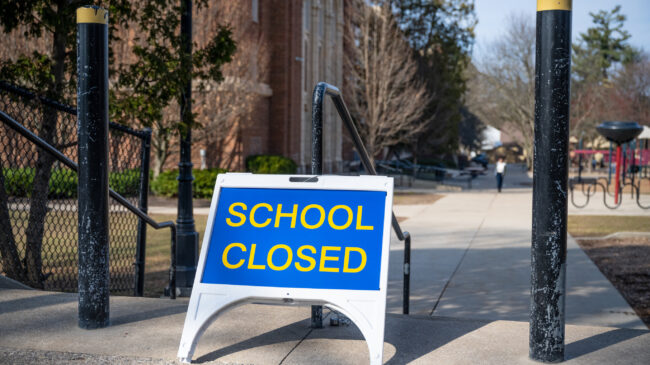Breaking news this week: The latest National Assessment of Educational Progress (NAEP) scores show that COVID-19 pandemic-related learning loss has reversed decades of incremental math and reading test score progress. While the education world digs into this record decrease in the test scores of fourth and eighth graders, there will be a lot of political rhetoric and forthcoming research about the impact of in-person learning compared to at home-learning. But not a single state posted an increase in its test scores, so there is work to be done to help students everywhere, and we’ll delve into some of that in future newsletters.
Relatedly, the U.S. Census Bureau recently released preliminary K-12 school spending data that show how COVID-19 challenges and federal pandemic relief funding impacted K-12 school systems in the 2020-2021 school year.
Taken together, these two data sets provide critical insight into how the pandemic and policymakers’ decisions likely changed public education forever.
The Census data from the Annual Survey of School System Finances currently includes data from 40 states and Washington, D.C., with 10 states yet to report their spending information, including Indiana, Louisiana, Tennessee, and Texas. It is likely those states’ figures will largely follow the finance trends already reported by a majority of states.
Overall, the Census findings show state education revenues increased in 27 of 40 states between the 2019-2020 and 2020-2021 school years. Despite temporary disruptions to some tax revenue streams due to the COVID-19 pandemic, most states increased state dollars dedicated to K-12 education. These funding increases follow the trend of the past 20 years, where nearly 90% of states increased state education spending between 2002 and 2020.
Federal revenue streams for K-12 public schools saw the largest increase, growing more than 45% between the 2019 and 2021 fiscal years. And it is important to note that the preliminary 2020-2021 Census education data reflects only $20.7 billion of the nearly $200 billion in federal funds allocated to states during the pandemic. As of August 18, 2022, school districts had yet to spend $130 billion in Elementary and Secondary School Emergency Relief (ESSER) funds, despite the fast approaching 2024 deadline for using them.

The Census report shows that some education costs directly impacted by the pandemic decreased, such as pupil transportation, food services, and administration that weren’t needed when in-person learning was shut down. In the 40 reporting states and Washington, D.C., per-pupil transportation expenditures dropped by nearly 13% on average between the 2019-2020 and 2020-2021 school years.
Yet during that time, other spending categories understandably increased as school systems navigated the pandemic’s challenges. For instance, pupil support spending increased in all states except Colorado, Massachusetts, New York, and South Carolina. As schools implemented COVID-19 safety precautions, spending on operation and maintenance increased in every state except New York, Massachusetts, and New Jersey. Because states have yet to finalize their official reports to Census, some spending categories could contain irregularities. For example, New York and Massachusetts’ preliminary data appear to be underestimating spending in numerous categories.
We should expect the final 2020-2021 Census report to show significant overall increases in instruction and pupil support because many school districts hired staff and implemented new programs in an attempt to reverse student learning loss during the pandemic. Seeing which states had the highest increases in categories like instruction staff support and administration will provide insight into school districts’ priorities and hiring decisions during extended school closures.
But the just-released NAEP scores make one thing clear: billions of dollars, much of it not spent yet, in federal funding did little to make up for students’ lost time in the classroom during the worst of the pandemic.
This data also reinforces the argument that states and school districts should invest their remaining ESSER funding in priorities like math and reading tutoring and programs that provide funds directly to families so they can enroll their students in educational services that can help them get back on track.
From the States
School choice debates making an impact on gubernatorial elections nationwide
In Pennsylvania, school choice is playing a unique role in the gubernatorial race between the Republican Doug Mastriano and Democrat Josh Shapiro, who has bucked the typical Democratic Party platform by supporting “lifeline” scholarships for students in the state’s lowest-performing schools. While this program, which helps pay for private or public school tuition, is more modest than education choice proposals Mastriano would likely push if elected, it is estimated that lifeline scholarships would provide school choice access to nearly 200,000 Pennsylvania students.
Texas Gov. Greg Abbott recently signaled his support of expanding school choice if reelected. Abbot signed a $6.5 billion K-12 education spending increase in 2019, but his recent support of choice has fueled Beto O’Rouke’s campaign claims that Abbott supports defunding public education in Texas. For years, Republican lawmakers representing Texas’ rural legislative districts have largely rejected school choice proposals. The Texas Tribune recently reported that O’Rouke is trying to capitalize on this fact by “running newspaper ads in at least 17 markets, mostly rural, that urge voters to ‘reject Greg Abbott’s radical plan to defund’ public schools.”
Similarly, in Oklahoma, the state’s Superintendent of Public Instruction Joy Hofmeister calls school choice programs a “rural school killer.” Hofmeister, a former Republican, switched her party affiliation last year to run against Gov. Kevin Stitt, in part due to Stitt’s embrace of school choice and funding students instead of systems.
Following the passage of Arizona’s Empowerment Scholarship Account, Republican gubernatorial candidate Kari Lake said she supports “100% backpack funding” for students, and would likely attempt to continue the school choice legacy of outgoing Gov. Doug Ducey if elected. Democrat Katie Hobbs, who supported a failed union-backed campaign to overturn the ESA bill, says she wants to increase accountability requirements for charter schools and has criticized state leaders for “kicking the can down the road” on public education spending. Arizona lawmakers sent an additional $1 billion to public schools in their last session.
What to watch
More Analysis of the NAEP Drop in Math and Reading Scores
More on the National Assessment of Educational Progress (NAEP) national testing results: Eighth and fourth graders experienced massive declines in average NAEP math scores, dropping eight and five points, respectively. At the same time, both eighth and fourth-grade students’ average scores in reading declined by three points. “Normally, for a NAEP assessment … we’re talking about significant differences of two or three points. So an eight-point decline that we’re seeing in the math data is stark. It is troubling. It is significant,” Peggy Carr, commissioner of the National Center for Education Statistics, told reporters. In math, the lower NAEP scores reverse the gains of approximately 20 years, while in reading, NAEP scores are now at the same levels as they were 30 years ago, in 1992.
Kentucky’s School Choice Program Before the State Supreme Court
The Kentucky Supreme Court heard arguments earlier this month about the state’s Education Opportunity Account Program, a tax-credit education savings account that opponents say sends taxpayer dollars to private schools in a way that violates the state constitution. The ESA program was vetoed by Gov. Andy Beshear in 2021 but became law when the legislature overrode the veto. The state Supreme Court is expected to rule on the issue in the coming months.
Recommended Reading
Nation’s report card shows steep declines in student learning
Martin R. West at Education Next
“We see that the vocal efforts of Florida Gov. Ron DeSantis and Texas Gov. Greg Abbott to reopen schools early were not enough to keep students from losing roughly the national average decline of eight points in eighth-grade math… But any efforts to claim credit for them will be complicated by the fact that California students lost only six points in eighth-grade math—far less than would be expected given the slow return to in-person instruction seen under Gov. Gavin Newsom—and also fared well on a relative basis in other grades and subject areas.”
Public education missed the data revolution. It’s time to catch up
Marguerite Roza and Chad Aldeman at The Hill
“Good luck getting real-time data on how many children are enrolled in public schools, are chronically absent, or are making academic progress as a result of federally funded relief efforts. We don’t have it on a national level. States don’t have it. Neither do most districts.”
Encouraging education entrepreneurship
Kerry McDonald at State Policy Network
“Entrepreneurs confront challenges in all sectors, but it became clear from these focus groups and interviews that education entrepreneurs often encounter more obstacles than others. The strict K–12 regulatory environment in most states can create significant barriers to entry and growth.”

